Do you have a question about the Campbell Hausfeld TQ3010 and is the answer not in the manual?
Details the use of air compressor units to power pneumatic tools and operate spray guns.
Explains the meaning of Danger, Warning, Caution, and Notice symbols to prevent injury and equipment damage.
Warns about chemicals known to cause cancer and birth defects. Recommends washing hands.
Mandates specific safety equipment for applications requiring breathable air quality.
Instructions for inspecting the unit for damage during transit and tightening loose fittings before use.
Instructs users not to return the product to the retailer but to contact customer assistance.
Advises on electrical arcs igniting flammable gases and avoiding flammable liquids near the compressor.
Covers operating without a belt guard, loose clothing, hot parts, and vibration.
Details ASME safety valve requirements and maximum operating pressure settings.
Warns against modifying the tank and stresses regular draining and inspection for rust.
Requires power disconnection and pressure release before installation or service.
Advises using properly rated equipment and not lifting by tubes or coolers.
Specifies installation in a clean, ventilated area with adequate clearance and temperature limits.
Prohibits locating the air inlet near sources of contamination like steam or paint spray.
Details bolting the tank to a concrete floor, using vibration isolators, and flexible hoses.
Prohibits PVC pipe for compressed air and specifies pressure ratings for all piping components.
Instructs to install a shut-off valve on the discharge port, not between pump and tank.
States all wiring must be performed by a qualified electrician according to local and national codes.
Provides minimum recommended copper wire sizes based on HP and voltage for compressor installations.
Emphasizes proper grounding of electrical components to prevent shock hazards.
Details the requirement for overload protection for all motors, noting built-in protection for some frames.
Specifies branch circuit protection requirements per the National Electrical Code for motors.
Instructions for changing voltage and adjusting magnetic starters or overload elements.
Explains the importance of correct counterclockwise rotation and how to reverse phase motors.
Emphasizes checking motor rotation and installing water/oil removal equipment.
Mandates installation of belt guards and electrical covers before operating the unit.
Details filling the crankcase with specified compressor oil before operation.
Specifies a one-hour continuous run with the drain valve open for piston ring seating.
Advises periodic running to prevent condensation in the crankcase and oil contamination.
Notes that converting to continuous run requires a separate unloading device and check valve removal.
Explains moisture formation and its impact on paint jobs and sandblasting, suggesting filters.
Requires disconnecting power and releasing pressure before any maintenance.
Instructs daily checks of the safety valve by pulling the ring and replacing if faulty.
Stresses daily draining and annual inspection of the tank for cracks or welds.
Never run without a filter; clean with compressed air or replace if clogged.
Requires wearing gloves and checking/cleaning intercooler fins weekly for dirt and dust.
Monthly cleaning of cylinder head, motor, fan blades, etc., using light air pressure.
Check belt tension every 3 months, adjusting for 3/8-1/2 inch deflection and proper alignment.
Possible causes include low voltage, motor winding issues, or pressure switch problems.
Addresses high pressure switch settings, faulty check valves, incorrect fuses, or loose wiring.
Covers loose parts, lack of oil, improper mounting, or malfunctioning check valves.
Troubleshooting milky oil, excessive oil consumption, and water in discharge air.
Addresses tanks not holding pressure, worn check valves, or leaks.
Troubleshooting ASME safety valve popping open or pressure switch issues.
Details the one-year warranty period and coverage for material and workmanship defects.
Lists items not covered, including normal wear parts, misuse, and commercial use limitations.
Outlines purchaser duties like providing proof of purchase and calling for service.
This document provides comprehensive information regarding the installation, operation, and maintenance of Campbell Hausfeld air compressors, specifically models TF2101, TF2111, TQ3010, TQ3011, TX2101, and TX2118. It also includes important safety guidelines and warranty information.
Campbell Hausfeld air compressor units are designed to generate compressed air for various applications. Their primary functions include powering pneumatic tools, operating spray guns, and supplying air for pneumatic valves and actuators. The pumps in these units utilize oil-lubricated bearings, which means a small amount of oil carryover will be present in the compressed air stream. For applications requiring oil-free air, an appropriate filter must be installed. The compressors are designed for stationary installation on a solid floor, and any other use will void the warranty and absolve the manufacturer of responsibility for issues arising from misuse. The manual differentiates between single-stage and two-stage compressors, which impacts certain specifications and operational procedures.
While specific numerical specifications like CFM (Cubic Feet per Minute) or horsepower are not explicitly listed for each model in the provided pages, the manual does highlight several critical technical aspects and requirements:
| Brand | Campbell Hausfeld |
|---|---|
| Model | TQ3010 |
| Category | Air Compressor |
| Language | English |
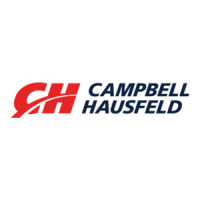

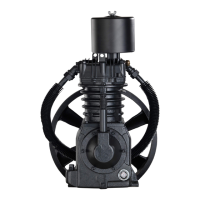
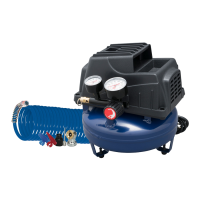
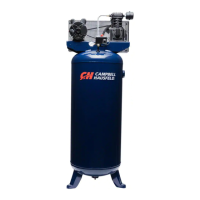
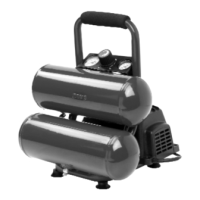
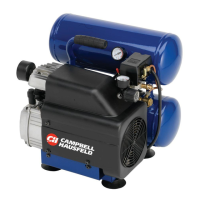


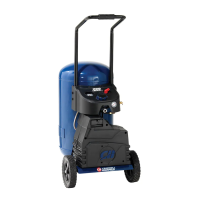


